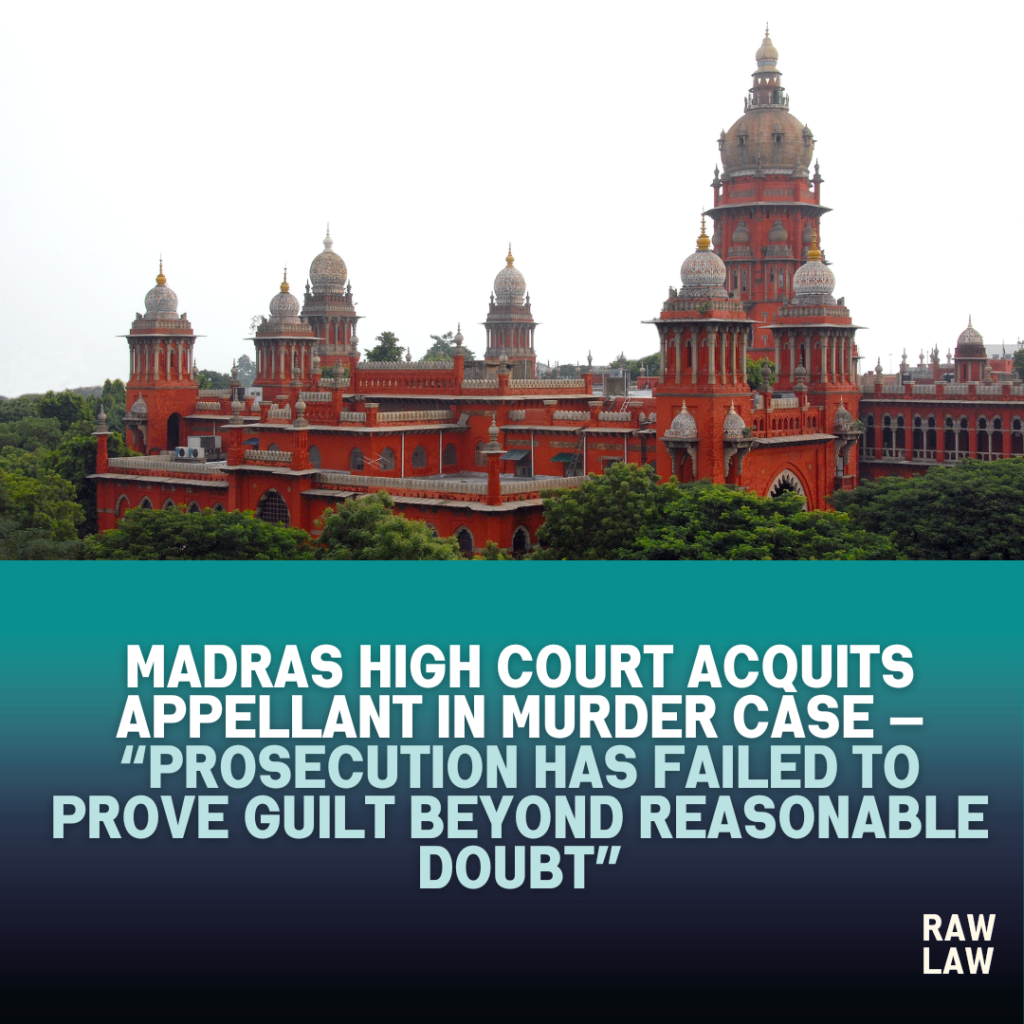Court’s Decision
The Madras High Court set aside the conviction of the appellant for murder under Section 302 of the Indian Penal Code, holding that the prosecution failed to establish guilt beyond reasonable doubt. The Bench observed that the trial court’s reliance on doubtful and inconsistent evidence was unsustainable. The Court emphasised that in cases resting on circumstantial evidence, “each circumstance must be fully established and form a complete chain leading only to the guilt of the accused.” The appellant was acquitted, and the conviction and sentence were quashed.
Facts
The case arose from an incident where the deceased was found dead in a local area under suspicious circumstances. The prosecution alleged that the appellant had committed the murder following a dispute, relying primarily on circumstantial evidence, including alleged last-seen witnesses and purported recovery of incriminating material. The trial court convicted the appellant under Section 302 IPC and sentenced him to life imprisonment.
The appellant challenged the conviction, contending that the evidence was contradictory and the chain of circumstances was incomplete. The defence further highlighted that independent witnesses did not support the prosecution’s narrative, and material recoveries were fabricated.
Issues
- Whether the prosecution had proved the guilt of the appellant beyond reasonable doubt through reliable and legally admissible evidence.
- Whether the trial court erred in convicting the appellant on the basis of circumstantial evidence without establishing a complete chain linking him to the crime.
- Whether the alleged recovery and last-seen theory could be sustained in law given the contradictions in witness testimonies.
Petitioner’s Arguments
The appellant contended that the prosecution case was riddled with inconsistencies. It was argued that the “last-seen” theory was unreliable because there was no conclusive evidence placing the appellant with the deceased at the relevant time. The appellant submitted that the recovery of incriminating objects was doubtful as independent witnesses to the recovery had turned hostile. Further, the motive alleged by the prosecution was speculative, lacking independent corroboration. The defence stressed that suspicion, however strong, cannot replace proof, and the conviction was based on conjectures rather than conclusive evidence.
Respondent’s Arguments
The prosecution maintained that the circumstantial evidence, taken cumulatively, was sufficient to prove guilt. It was argued that the “last-seen” evidence, coupled with the alleged recovery of the murder weapon and motive, pointed unerringly towards the appellant’s involvement. The prosecution submitted that minor contradictions in witness statements did not undermine the overall reliability of the case. It was also argued that the trial court had rightly drawn adverse inferences from the appellant’s failure to explain the circumstances leading to the death.
Analysis of the Law
The Court reiterated the settled principle that in a case based solely on circumstantial evidence, each link in the chain must be proved beyond reasonable doubt, and the chain must be so complete that it leaves no room for any hypothesis other than the guilt of the accused. Referring to the standards under Sections 101 and 102 of the Indian Evidence Act, the Court emphasised that the burden lies squarely on the prosecution to establish its case. The Court noted that the benefit of doubt must always go to the accused when the evidence is susceptible to multiple interpretations.
Precedent Analysis
The Court relied on Sharad Birdhichand Sarda v. State of Maharashtra (1984) 4 SCC 116, which lays down the “five golden principles” for conviction on circumstantial evidence, and Hanumant Govind Nargundkar v. State of M.P. (1952 SCR 1091), emphasising that the circumstances must exclude every hypothesis except the one proposed to be proved. It also referred to Navaneethakrishnan v. State (2018) 16 SCC 161, reiterating that the last-seen theory must be supported by strong corroborative evidence.
Court’s Reasoning
The Court found that the prosecution had failed to establish the last-seen circumstance with certainty, noting that witness testimonies were inconsistent and contradictory. The alleged recovery was deemed unreliable due to the absence of credible independent witnesses and the possibility of planting evidence. The Court observed that the motive put forth by the prosecution was weak and not substantiated by convincing evidence. Applying the “five golden principles” from Sharad Birdhichand Sarda, the Court concluded that the chain of circumstances was incomplete, making the conviction unsafe.
Conclusion
The conviction and sentence of the appellant under Section 302 IPC were set aside. The Court directed that the appellant be released forthwith unless required in any other case. The judgment reaffirmed that suspicion, however grave, cannot substitute for proof and that in criminal cases, the benefit of doubt must invariably go to the accused.
Implications
This judgment reinforces the high standard of proof required in cases based on circumstantial evidence. It serves as a reminder to trial courts that conviction cannot rest on conjecture or incomplete chains of evidence. It also reaffirms that hostile witnesses, doubtful recoveries, and speculative motives significantly weaken the prosecution’s case.
Referred Cases and Their Relevance
- Sharad Birdhichand Sarda v. State of Maharashtra — Laid down the five golden principles for conviction on circumstantial evidence, applied to conclude that the prosecution’s chain was incomplete.
- Hanumant Govind Nargundkar v. State of M.P. — Emphasised that circumstances must point only to guilt and exclude all other hypotheses.
- Navaneethakrishnan v. State — Cited to underline that last-seen theory alone is insufficient without strong corroboration.
FAQs
Q1: What is the “five golden principles” rule in circumstantial evidence cases?
It is a set of guidelines from the Supreme Court in Sharad Birdhichand Sarda, requiring that all circumstances must be fully established, form a complete chain, and exclude all other hypotheses except guilt.
Q2: Can the last-seen theory alone convict an accused?
No. Courts require corroboration from other reliable evidence before convicting solely on the last-seen circumstance.
Q3: What happens if prosecution witnesses turn hostile?
If crucial witnesses turn hostile and the prosecution fails to prove its case through other reliable evidence, the accused is entitled to acquittal.



